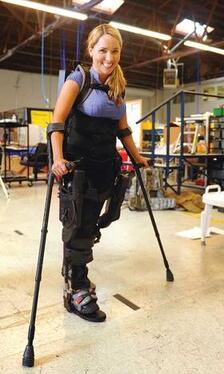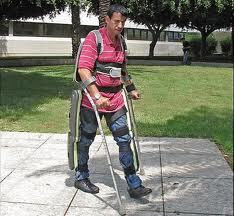
Taking a Walk with ReWalk
Posted August 16, 2012 at 7:00 pm
By Sarah Drexelius, ContributorAfter taking a tour at the Museum of disABILITY History, the picture showing the “Re-Walk,” a robotic exoskeleton immediately captured my attention. Although there were other incredible artifacts and displays about how far technology and society has come in relation to disabilities, this sparked my interest the most.
My aunt was diagnosed with multiple sclerosis (MS) at the age of 19 and she is now in her 40s. As the disease progresses, walking is more challenging than it was even a year ago. She walks with a cane and sometimes a walker or even gets pushed in a wheelchair if the distance is too far or if her legs “aren’t working that day.” Although she remains positive and active in her social life, she wishes that she could walk, swim and do artwork again.
Once I left the Museum and began researching the “ReWalk,” I learned that there were a few different bionic companies that have been working on models similar to that and have been successful. I also learned that another company, nearly 50 years ago, created a powered exoskeleton but it was never successful. Amazingly, 50 years later, Argo Medical Technologies and Ekso Bionics were able to create a design by fusing together their innovative minds and new advancements in technology. They were able to bring their concepts to life by designing and creating an exoskeleton that allows the user to control the movements of it. The models such as the ReWalk and Ekso exoskeleton allow those who are severely disabled to walk again.

Ekso Bionics, is a California-based company, who created a “robotic prosthesis that functions as a second pair of legs … there are over 30 sensors that work together on the device to enable life-like walking.” Once Ekso Bionics began testing their robot to see if it worked, they had a total of 63 patients who were paraplegia-afflicted who could not walk by themselves beforehand. But, each one of those patients who used Ekso Bionics’ robot regained mobility and on average, they could walk over 200 steps. I was absolutely amazed not only with the technology behind it, but also the success stories of those who tested it out.

Even though it makes me hopeful for my aunt and everyone else who would be able to regain their movement, robotic exoskeletons like these come at a substantial price. Currently, this exoskeleton is $130,000, which includes training, but they are hoping to lower the price by trying to raise funds for it. Ekso Bionics expects to create a newer and better exoskeleton that costs less and can join in the commercial world so that those who are in need are able to purchase one. Ekso Bionics hopes that they can create their model without any therapist supervision by 2014.
Besides Ekso Bionics, an Israeli company, Argo Medical Technologies, is the company who created the model called “ReWalk” and unlike the Ekso Bionic model, ReWalk does not require having a therapist for support. In addition, Argo’s model comes in two sizes and can support someone up to 220 lbs. Argo’s product is a motorized exoskeleton that “consists of a light wearable brace support suite, motion sensors, a computer system and tailored rechargeable batteries.” This allows those who have spinal cord injuries or serious walking disabilities to be able to walk again. The interesting and great thing about the ReWalk is that besides all of the technology behind it, the person wearing the device is the one who controls it, not the therapist. Based on the sensors that are on the ReWalk, one is able to walk, sit, stand and go up and down stairs or slopes. Not only is the ReWalk great for those who want to get around more easily, but it is also much better for people’s health. When one stays in a wheelchair for too long, it may create severe issues in the digestive, cardiovascular, urinary and respiratory systems. So, by using the ReWalk, one can move around and avoid some of these problems. ReWalk can also prevent the constant need of a therapeutic or physical trainer and can allow more independence.
ReWalk is continuing to further the advances of their device and hopes to make it more readily available to all with disabilities. But, the good news is that ReWalk is in many rehabilitation centers and hospitals throughout Europe and the United States of America. ReWalk is already in the commercial market and hopes that they can create a bigger impact by figuring out how to cut costs. Recent technological advancements such as the ReWalk offer hope to many, such as my aunt, that the future may hold.
Resources:
http://www.cbsnews.com/8301-504763_162-57421328-10391704/prosthetic-exoskeleton-helps-paraplegics-walk-again-at-u.s-rehab-centers/
http://www.argomedtec.com/products.asp
http://images.gizmag.com/hero/rewalk.jpg
http://abcnews.go.com/GMA/OnCall/bionic-breakthrough-robotic-suit-helps-paraplegics-walk/story?id=9741496
http://www.disabledlifemedia.com/wp-content/gallery/exoskeleton/ekso-bionics-1.jpg
- Category
- Museum of disABILITY History Blog
- Tags
- Adaptive Equipment | Paralysis | Research | ReWalk | Technology and Disabilities

Comments
Add a comment